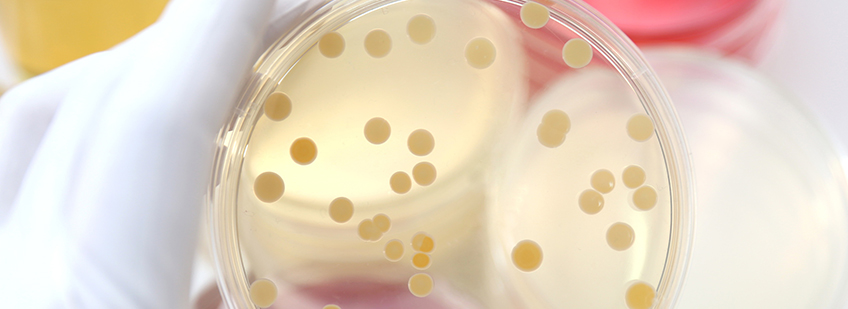04 October 2018 / The experts of the Vitagora ecosystem / Vitagora publication / Science and technologies
Listeria monocytogenes - new leads for reducing the risk of food contamination
This article is also available in French
 Listeriosis is an infection caused by the consumption of food contaminated by Listeria monocytogenes. There are few infections annually, but mortality is high. Of course, the food industry applies stringent hygiene measures but these bacteria have features that help it to survive and proliferate. What are these features? Which leads are being pursued by research to eradicate it from food factories? Which variables modulate its virulence and survival?
Listeriosis is an infection caused by the consumption of food contaminated by Listeria monocytogenes. There are few infections annually, but mortality is high. Of course, the food industry applies stringent hygiene measures but these bacteria have features that help it to survive and proliferate. What are these features? Which leads are being pursued by research to eradicate it from food factories? Which variables modulate its virulence and survival?
Why this should interest you
- Listeria monocytogenes are pathogenic bacteria that proliferate on food. If ingested, the bacteria can cause listeriosis in vulnerable subjects.
- Transmission of the bacteria to humans is by food in 99% of cases.
- Listeria monocytogenes proliferates at refrigeration temperatures and persists in food retail outlets and on equipment.
- Ongoing research is vital to ensure consumer health and safety. We need to improve our capacity to assess strain virulence, to detect biofilms and to design disinfection tools for the food industry.
Pork tongue in jelly, potted meat, Brie cheese, Epoisses cheese, mortadella... These foods have one thing in common: they have all caused listeriosis outbreaks in France. The disease is caused by Listeria monocytogenes. The bacteria is well known to the industry, but we have not yet succeeded in eradicating it from food factories. At the end of August 2018, several products (cooked meats, falafel) of a large brand were recalled in France due to a risk of contamination by L. monocytogenes. Proof that there is still room for improvement to avoid contamination by the bacteria.
Certain at-risk populations (pregnant women, immunocompromised patients, transplant recipients, patients with invasive treatment like chemotherapy, people with liver problems and the elderly) are in danger of contracting listeriosis, a generalised bacterial infection, if they eat food that is highly contaminated by the bacteria. The number of cases is limited, with for example 250 to 300 cases per year in France, but the consequences can be catastrophic: sepsis, meningitis, foetal infection or miscarriage. When listeriosis is diagnosed, mortality is between 15 and 30%.
These bacteria are a major risk for consumer health. The problem concerns many industries such as farming, breeding and retail but the problem is most prevalent in food processing factories. Read on to discover promising leads for eradicating Listeria. Monocytogenes and reducing its virulence.
Member of the academic staff in microbiology and coordinator of the European List_MAPS project, Pascal Piveteau presents us his expert view of Listeria monocytogenes referring to scientific results from the project.
Pascal Piveteau
At the heart of microbiology
After engineering school, a thesis in microbiology and two postdoctoral placements, Pascal was recruited as a lecturer by the University of Burgundy in September 2000. He teaches microbiology at the IUT of Dijon, specialising in food and biological industries. Pascal Piveteau is part of the AgroEcology joint research unit at INRAE Dijon, and more specifically the MERS team (environmental microbiology and health risks), which aims to characterise the circulation of potentially pathogenic microorganisms between agroenvironments, abiotic environments and plants and animals, as well as their capacity to adapt to different environments.
List_Maps project
Pascal Piveteau is also the coordinator of the List_MAPS project. This project is part of the European Union’s Marie Sklodowska-Curie programme and part of the Horizon 2020 project. The project brings together 11 PhD students and 9 European laboratories in France, Germany, Denmark, Ireland and the Netherlands. A PhD programme, it combines research and professional education in various fields: technical, general, entrepreneurial and cross-cutting disciplines. Once recruited, young researchers prepare a thesis and participate in a general scientific project concerning Listeria monocytogenes.
The project is backed by a network of academic and private partners, creating an interface between academic research and the food industry.
Scientific objectives of the project:
- Understanding how soil, plants, biofilms and food matrices influence the physiology and ultimately the virulence of monocytogenes.
- Modelling the regulatory network that allows it to adapt to changes in its environment.
- Assessing the variability of infectious strength between different strains and the ability to form biofilms according to environmental conditions.
- Developing a system for assessing virulence that avoids the use of animals.
"The network combines expertise in several external environments as well as biofilm production, virulence and the role of food composition in the development of infection," says Pascal Piveteau.
Listeria monocytogenes: Know your enemy
The List_MAPS project has succeeded in bringing to light several characteristics of Listeria monocytogenes that are vital if we are to learn how to control it better.
Proliferation is possible at 0°C
The food industry applies a range of measures, including disinfection, cleaning and refrigeration to reduce the risk of contamination by bacteria, viruses, fungi and parasites. However, L. monocytogenes is particularly problematic due to one of its features. “It is able to persist in the food factories because it continues to proliferate at refrigerated temperatures," Pascal says. "A food factory has an environment conducive - at least, is not unconducive to - the growth and persistence of these bacteria.”
Preventing biofilm formation: the key in the fight against L. monocytogenes
"A lot of research has been done into this bacteria, particularity its ability to infect humans," explains Pascal. Many laboratories are working on ways to eliminate it. One potential solution is to prevent the formation of biofilms.
A biofilm is a form of adaptation that increases the bacteria’s persistence. They form a "community" surrounded by an extracellular matrix that protects them from aggression by external factors such as UV, acidic pH and antimicrobial compounds. Several types of bacteria can be found inside, pathogenic or non-pathogenic. Once formed, biofilms are difficult to completely remove, making it difficult to eradicate potentially pathogenic bacteria.

Biofilms resist dehydration
"PhD students studied the mechanisms for biofilm growth as well as the effects of stress, such as dehydration, on the bacteria’s survival both as biofilm and liquid culture. Most bacteria do not survive dehydration. But thanks to the formation of a biofilm, L. monocytogenes can survive up to 49 days. A biofilm appears to protect against dehydration, using molecular mechanisms to adapt and resist. Understanding these phenomena is critical for designing effective treatments. But it is even more important to prevent this form of resistance, as it is difficult to eradicate.
Soil microorganisms modulate survival of L. monocytogenes
PhD students on the List_MAPS project have also shown the link between soil characteristics and the ability of this bacteria to survive. "We have shown that there is a direct link between the composition and structure of soil microorganism communities and the bacteria’s capacity to survive. The bacteria’s chances of survival vary with microorganisms in the soil," says Pascal. Microorganisms are capable of secreting molecules into their environment, including antibiotics that prevent the proliferation of certain bacteria. It appears that somr are capable of preventing the survival of L. monocytogenes.
These results will be of particular interest to the agricultural world, also concerned with protecting their soils and crops against bacteria. Preventing the propagation of L. monocytogenes in fields and crops is a first step to limiting contamination of humans and animals (who are also susceptible to listeriosis).
Food composition affects L. monocytogenes’s virulence and capacity for survival
It has also been suggested that we learn more about the relationship between food composition and the likelihood of infection. "The ability to survive the stresses of the digestive tract (including the stomach, intestines and colon) and the chances of causing systemic infection depends on the molecules in food," he continues. Like any living being, bacteria need nutrients to grow and proliferate. The fact that Listeria monocytogenes needs certain nutrients to survive in the host provides potential for solutions for the food industry. Further studies are needed to identify dietary compositions capable of disabling the bacteria.
One project ends... a new program begins
"List_MAPS is an educational network for PhD students. We educate them in all the different professions they are likely to practise in their career, both from academic and private sector perspectives," explains Pascal.
The project ends in May 2019, but several questions about L. Monocytogenes persist. Particularly about the biodiversity of the species. Some strains are more virulent than others. It would be useful to find an explanation for these differences and to explain the link between the bacterial genome and the degree of virulence. Another question persists about the relationship between the food matrix and the virulence of L. monocytogenes. The consortium has decided to submit a new application for funding for these two research themes.
Keywords
Listeria monocytogenes, bacteria, microorganism, listeriosis, infection, food, food industry, project, research
Further reading
- Esbelin J, Santos T, Hebraud M.2018. Desiccation: An environmental and food industry stress that bacteria commonly face. Food Microbiol. Volume: 69 Pages: 82-88. DOI: 10.1016/j.fm.2017.07.017
- Vivant AL, Desneux J, Pourcher AM, Piveteau P. 2017. Transcriptomic Analysis of the Adaptation of Listeria monocytogenes to Lagoon and Soil Matrices Associated with a Piggery Environment: Comparison of Expression Profiles. Front Microbiol. 2017 Sep 26;8:1811. DOI: 10.3389/fmicb.2017.01811. eCollection 2017
- Gahan CGM, Hill C. 2014. Listeria monocytogenes: survival and adaptation in the gastrointestinal tract. Front Cell Infect Microbiol. Volume: 4. Article Number: 9. DOI: 10.3389/fcimb.2014.00009
- Vivant AL, Garmyn D, Piveteau P. 2013. Listeria monocytogenes, a down-to-earth pathogen. Front Cell Infect Microbiol Volume: 3 Article Number: 87 Published Nov 2013 DOI: 10.3389/fcimb.2013.00087
Article produced in partnership with JFD&Co
|
Find out more...Elodie Da Silva, Vitagora's Innovation team leader, is here to help. If you are interest in the results of the List_MAPS project, contact her at: elodie.dasilva@vitagora.com
A food engineer from the French city of Toulouse, Elodie devotes her considerable energies to leading Vitagora's team of food innovation professionals in supporting members' innovation activities. |




 Home
Home



















